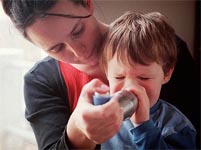Immunotherapy against pollen allergy can help prevent asthma
 Hamburg, Germany - Spring has arrived in the northern hemisphere - and with it, a time of suffering for those who are susceptible to hay fever. About 10 million people in Germany are allergic to pollen, said the Association of German Allergists in Hamburg, northern Germany,.
Hamburg, Germany - Spring has arrived in the northern hemisphere - and with it, a time of suffering for those who are susceptible to hay fever. About 10 million people in Germany are allergic to pollen, said the Association of German Allergists in Hamburg, northern Germany,.
Although most sufferers try to deal with the symptoms themselves, that can have potentially dangerous consequences.
"At least one third of all patients, who have an allergy that they don't treat properly, will suffer from allergic asthma in the short or long term," said Thomas Fuchs, a representative of the association.
Starting a course of immunotherapy as early as possible is the best way of avoiding complications.
"In the best case scenario, you begin immunotherapy at a maximum of five years after the symptoms of a pollen allergy appear," says Professor Karl-Christian Bergmann from the Allergy Centre at Berlin's Charite University Clinic.
The earlier immunotherapy begins, the fewer allergies are present and the less developed they are, thereby improving the chances of a successful therapy.
Immunotherapy begins when the body is exposed to a very low concentration of the allergen. The dosage is then slowly increased over a long period of time.
As the concentration is increased, the body's immune system becomes less sensitive to the allergen.
"The effectiveness of this treatment has been proven in many studies and is very successful when it comes to hay fever sufferers," says Anja Schwalfenberg, a biologist and consultant at the German Allergy and Asthma Association in Moenchengladbach.
But Schwalfenberg advises against following a specific course of immunotherapy in cases of severe asthma or asthma that has not been treated properly.
"The gold standard among forms of therapy is what is known as subcutaneous therapy, where the allergen is injected under the skin," explains Heidrun Holstein, a doctor at the Consumers Association office in Karlsruhe.
But this type of therapy takes a long time to complete. "In the beginning, the patient receives an injection between two and three times a week in a clinic. In some cases, a long-acting agent which releases the allergen over a period of time may be injected once a week."
This therapy is begun before the hay fever season starts. Side effects include drowsiness or in extreme cases allergic shock, which is why patients must remain under observation in the clinic for 30 minutes after being treated.
Researchers have developed alternative treatments that no longer require the patient to receive an injection.
Sublingual therapy consists of drops of vaccine that are placed in the patient's mouth. Grass allergies can be treated with tablets.
The most noticeable side effect of injected vaccines has been observed in patients such as asthma sufferers who have oversensitive bronchi.
"Those patients should receive a course of drops under medical observation," advises Bergmann.
All other patients should consult their doctor every three months to receive a new prescription. (dpa)